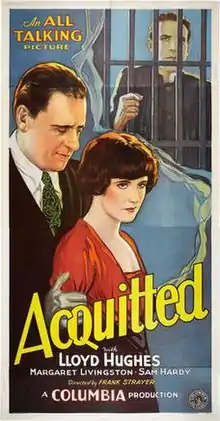| Acquitted | |
|---|---|
 Theatrical poster | |
| Directed by | Frank R. Strayer |
| Written by | Keene Thompson |
| Produced by | Harry Cohn |
| Starring | Lloyd Hughes Margaret Livingston Sam Hardy |
| Cinematography | Ted Tetzlaff |
| Edited by | David Berg |
Production company | |
| Distributed by | Columbia Pictures |
Release date |
|
Running time | 7 reels |
| Country | United States |
| Language | English |
Acquitted is a 1929 American melodrama directed by Frank R. Strayer, from a screenplay by Keene Thompson. The film stars Lloyd Hughes, Margaret Livingston, and Sam Hardy, and was released by Columbia Pictures on November 15, 1929.
Plot
Marian is sent to prison for a crime she did not commit. While there she meets fellow convict, Dr. Bradford, who has also been wrongly convicted of a murder. Marion believes his innocence and falls in love with him. Bradford tells her that it was Egan who framed him. Meanwhile, Egan has fallen in love with Marian, and when Marian is paroled, begins to woo her. She goes along with his romances, hoping to get the info she needs to free Bradford. However, Egan is warned of her intentions by associates who are still in the jail. When Egan confronts Marian, she admits her plan, but tells Egan of her love for Bradford.
Egan, pretending to help Marian out, agrees to get Bradford released, and pays one of his henchmen, Smith, to confess to the crime for which Bradford is in prison for. Once Bradford is released, Egan attempts to leverage his role in that release, to force Marian to marry him. When she refuses, he has Bradford kidnapped, intending to have him killed. Learning of it, an armed Marian confronts Egan, and when he refuses to divulge Bradford's whereabouts, she shoots him. Grievously wounded, Egan needs immediate medical attention. Regretting her action, she pleads with Egan to tell him where Bradford is, so that he can tend to the wound.
Once Egan tells her where he has Bradford stashed, Marian rushes to free him, returning to Egan, where Bradford tends to the gunshot wound. The woman and doctor are followed by the police, who overhear Egan confessing to the murder for which Bradford was originally convicted. The wound patched, Egan is taken to jail, while Bradford and Marian end up together.
Cast list
- Lloyd Hughes as Dr. Bradford
- Margaret Livingston as Marian
- Sam Hardy as Egan
- Charles West as McManus
- George Rigas as Tony
- Charles Wilson as Nelson
- Otto Hoffman as Smith
- Erville Alderson as Prison Warden (uncredited)
Production
In early September 1929, it was announced that Frank Strayer had been slated to direct the picture.[2] In late August it was announced that Lloyd Hughes, Margaret Livingston, and Sam Hardy were attached to the project.[3] With Lloyd Hughes and Margaret Livingston already cast in the lead roles, Charles Wilson and Otto Hoffman were added to the cast in early October.[4] The film was released on November 15, 1929.[5]
Reception
Harrison's Reports gave the film a positive review, calling it a "strong melodrama", although they found the moral of the story less than desirable, saying that "it glorifies a crook and a murderer". They felt the script and direction created an atmosphere of tense suspense. They particularly singled out the acting work of Sam Hardy.[6] The Motion Picture News also enjoyed the film, calling it a "Good Crime Drama". They complimented Lloyd Hughes and Margaret Livingston, while saying that they were outshone by Hardy, although they felt the plot was a bit hackneyed.[7]
See also
References
- ↑ "Acquitted: Detail View". American Film Institute. Archived from the original on September 24, 2017. Retrieved September 23, 2017.
- ↑ Ralph Wilks (September 5, 1929). "A Little From "Lots"". The Film Daily. p. 8. Retrieved October 3, 2017.

- ↑ "Coast Studio Survey". Variety. August 28, 1929. p. 21. Retrieved October 3, 2017.

- ↑ "Hollywood Happenings". The Film Daily. October 10, 1929. p. 11. Retrieved October 3, 2017.

- ↑ "Complete Release Chart". The Film Daily. November 30, 1929. p. 100. Retrieved October 3, 2017.

- ↑ "Acquitted". Harrison's Reports. November 9, 1929. p. 179. Retrieved October 3, 2017.

- ↑ "Acquitted". Motion Picture News. November 9, 1929. p. 36. Retrieved October 3, 2017.

External links
- Acquitted at IMDb
- Acquitted at the TCM Movie Database
- Acquitted at the American Film Institute Catalog
- Synopsis at AllMovie